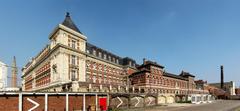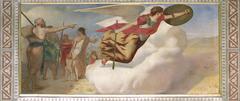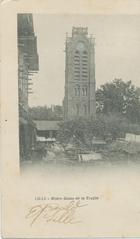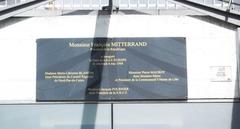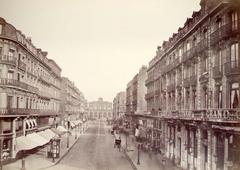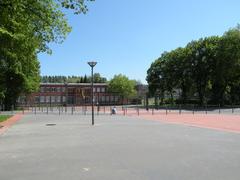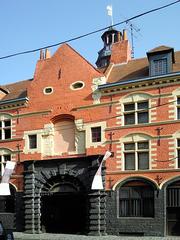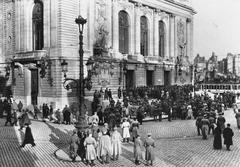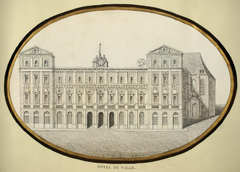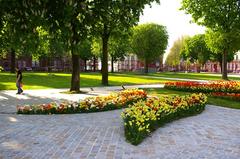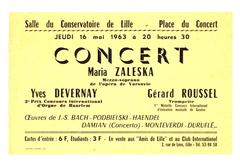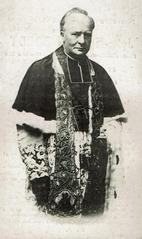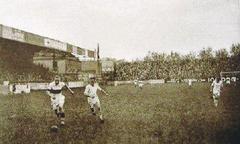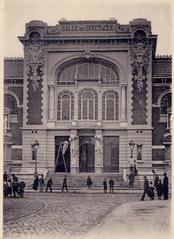Saint-Philibert Lille Visiting Hours, Tickets, and Travel Guide
Date: 04/07/2025
Discover Saint-Philibert in Lille: The Complete Visitor’s Guide
Saint-Philibert, set within the lively city of Lille, France, is a remarkable destination intertwining historical architecture, religious and academic heritage, healthcare excellence, and urban vibrancy. This guide unpacks everything you need to know for a rewarding visit—covering visiting hours, ticketing information, accessibility, transportation, and essential travel tips.
Whether you’re drawn by the medieval Saint-Philibert Church’s Romanesque and Flemish artistry or the 20th-century Saint-Philibert Polyclinic’s connection to the Université Catholique de Lille, the district offers a rich tapestry of experiences. Saint-Philibert also stands out as a vital transit hub, opening doors to Lille’s historical center and cultural attractions.
Table of Contents
- Introduction
- Historical Context and Foundation
- Architectural and Cultural Significance
- Visiting Hours and Ticketing
- Getting There: Transport and Accessibility
- Notable Events and Evolution
- Saint-Philibert Church: Hours, Tickets, and Highlights
- Practical Visitor Information
- Nearby Attractions
- Frequently Asked Questions (FAQ)
- Visuals and Interactive Elements
- Conclusion and Summary
- Sources and Further Reading
Introduction
Saint-Philibert in Lille is more than a location—it is a dynamic intersection of history, spirituality, architecture, and urban life. This guide brings together practical details and cultural insights, ensuring your visit is smooth and meaningful—whether you’re a history buff, architecture enthusiast, healthcare professional, or simply exploring Lille’s neighborhoods.
Historical Context and Foundation
Saint-Philibert Polyclinic and the district’s development are closely linked to the Université Catholique de Lille, founded in 1875 by Catholic visionaries Philibert Vrau and Camille Féron-Vrau. Their ambition was to establish a Catholic university, elevate Lille’s religious profile, and construct a church dedicated to Our Lady of the Treille. The university opened in 1877, initially offering law, literature, and science faculties (Université Catholique de Lille – History and Heritage).
The Saint-Philibert Polyclinic was built in 1927 for the university’s 50th anniversary, symbolizing a commitment to education and healthcare. Named after Saint Philibert, a 7th-century monastic figure, the polyclinic continues a tradition of religious veneration that also lives on in historic churches in Tournus and Dijon.
Architectural and Cultural Significance
The architecture of the Université Catholique de Lille—encompassing the Saint-Philibert Polyclinic—reflects a 13th-century Gothic influence reminiscent of English and American academic institutions. Architect Louis Dutouquet blended practicality with historical style, using brick and stone to harmonize with Lille’s architectural tradition (Université Catholique de Lille – Architectural Heritage).
The polyclinic, university church, and Sainte-Anne Maternity Hospital were built during a period of campus expansion, emphasizing an integrated approach to education, healthcare, and community service.
Role in Local Culture and Academic Life
Saint-Philibert is integral to Lille’s academic, spiritual, and medical fabric. The polyclinic serves students, staff, and the local community while offering professional training and healthcare. Its evolution mirrors advances in medicine and the university’s adaptation to modern needs (Université Catholique de Lille – History and Heritage).
Visiting Hours and Ticketing
Saint-Philibert Polyclinic:
- Visiting Hours: Educational or guided visits can be arranged on weekdays from 9:00 AM to 5:00 PM. Contact the university in advance for tours.
- Tickets: Entry is free for guided or educational visits by appointment. Medical areas are restricted to patients and staff.
- Accessibility: The polyclinic is fully wheelchair accessible, with ramps and elevators.
Saint-Philibert Church:
- Opening Hours: Typically open daily from 9:00 AM to 6:00 PM. Hours may vary during services or restoration; check the Lille Tourism website for updates.
- Tickets: Entry is free. Special tours or exhibitions may have a nominal fee.
- Guided Tours: Organized through the Lille tourism office or local associations.
Park and Ride (P+R):
- Hours: 24/7 operation.
- Fees: Usually integrated with metro tickets.
Getting There: Transport and Accessibility
Metro:
Saint-Philibert Metro Station (western terminus of Line 2) ensures seamless connections to Lille’s city center, train stations (Lille-Flandres, Lille-Europe), and major attractions. The station is equipped with elevators, ramps, tactile paving, and bilingual signage (UrbanRail.Net).
Park and Ride:
Secure, monitored parking is available at the metro station, streamlining access for drivers switching to public transit.
Cycling:
V’Lille bike-sharing stations provide an eco-friendly option for exploring the district and central Lille.
Notable Events and Evolution
- 1875–1877: Foundation of Université Catholique de Lille, merging education and faith.
- 1927: Construction of the polyclinic, university church, and Sainte-Anne Maternity Hospital.
- 20th–21st Centuries: Modernization and expansion of medical and academic facilities, preservation of architectural heritage (Université Catholique de Lille – Renovation Projects).
- Metro Development: Saint-Philibert Metro Station opened in 1989, cementing the district’s role as a transit hub.
Saint-Philibert Church: Hours, Tickets, and Historical Highlights
Introduction:
Saint-Philibert Church stands as a testament to Lille’s religious, architectural, and artistic evolution. Founded in the 12th century, it features Romanesque foundations, an apse échelon, a Carolingian crypt, and later Gothic additions. Flemish influences are evident in its materials and decorative details (Lille Tourism).
Visiting Hours:
Generally open 9:00 AM–6:00 PM, but confirm before visiting.
Tickets:
Entry is free; fees may apply for guided tours or special exhibitions.
Getting There:
- Metro: Rihour station (Lines 1 and 2) for the historic church; Saint-Philibert station (Line 2) for the modern district.
- Bus: Several lines serve the area.
Architectural Highlights:
- Romanesque Elements: Massive stonework, rounded arches, and monastic layout.
- Apse Échelon and Crypt: Unique stepped chapels; the crypt contains Saint Philibert’s sarcophagus from 839 (Church of St. Philibert, Tournus – Wikipedia; Medievalists.net – Saint-Philibert Church in Dijon).
- Gothic and Flemish Additions: Pointed arches, tracery, and brickwork reflecting local styles.
Art and Events:
Medieval statuary, carved capitals, and periodic exhibitions or concerts.
Accessibility:
Ramps and improved pathways for mobility-impaired visitors.
Practical Visitor Information
- Amenities: Cafés, shops, bakeries, and restrooms are available in the district.
- Medical Services: Hôpital Saint Philibert provides healthcare and emergency services (Saint Philibert Lomme Hospital).
- Safety: The area is secure, with CCTV and regular patrols. Exercise standard caution, especially during major events.
- Best Times to Visit: May–September for pleasant weather and festivals. The Braderie de Lille in early September is a highlight (France.fr).
- Family and Groups: Facilities are stroller-friendly; group travel passes available.
Nearby Attractions
- Parc Urbain de Lomme: Expansive park with trails and picnic spots.
- Vieux Lille: Cobblestone streets, boutiques, and historic churches.
- Palais des Beaux-Arts: Major art museum.
- Grand’Place and Vieille Bourse: Iconic city landmarks.
Frequently Asked Questions (FAQ)
Q: What are the visiting hours for Saint-Philibert Church and Polyclinic?
A: The church is generally open 9:00 AM–6:00 PM; the polyclinic allows visits by appointment on weekdays.
Q: Do I need tickets?
A: No tickets for general entry; guided tours or special events may require a fee.
Q: Are the sites accessible?
A: Yes, both are wheelchair accessible.
Q: How do I reach Saint-Philibert?
A: Metro Line 2 (Saint-Philibert station), buses, or cycling via V’Lille.
Q: Are there guided tours?
A: Yes, by prior arrangement via the university or tourism office.
Visuals and Interactive Elements
- Photos:
- Saint-Philibert Polyclinic’s façade (alt: “Saint-Philibert Polyclinic Lille facade”)
- Church interior with apse and crypt entrance (alt: “Interior of Saint-Philibert Church featuring the apse échelon and crypt access”)
- Maps:
- Interactive maps showing Saint-Philibert’s location within Lille, nearby attractions, and metro connections.
- Virtual Tours:
- Check Lille Tourism for virtual visit options.
Conclusion and Summary
Saint-Philibert offers a distinctive blend of Lille’s architectural grandeur, spiritual legacy, healthcare innovation, and urban convenience. The neighborhood’s accessibility via Metro Line 2, integration with university life, and proximity to Lille’s renowned sites make it an ideal base for travelers.
Whether exploring the Romanesque splendor of the church, the educational and medical contributions of the polyclinic, or the everyday vibrancy of the district, Saint-Philibert invites you to experience Lille’s rich tapestry first-hand. For the latest event schedules, guided tour options, and transit updates, consult official resources and consider downloading the Audiala app.
Plan your journey to Saint-Philibert and immerse yourself in a unique chapter of northern France’s cultural narrative.
Sources and Further Reading
- Université Catholique de Lille – History and Heritage
- Church of St. Philibert, Tournus – Wikipedia
- Medievalists.net – Saint-Philibert Church in Dijon
- Lille Tourism
- UrbanRail.Net – Lille Metro
- The Flashpacker – One Day in Lille Walking Tour
- France.fr – What to See and Do in Lille
- Independent – Lille Travel Guide
- Saint Philibert Lomme Hospital
- Ilévia Public Transport
- France Voyage
- Monsieur de France
- Happy to Wander - France Travel Tips
